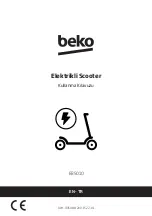
6.Specification
General use instructions and warnings
1.Battery
:
●
Never short circuit the discharge or charge terminals of
the battery
●
Never charge the battery by discharge terminals or
discharge the battery by charge terminals
●
Keep off the battery from fire and excessive heat. Never
put the battery into fire
●
To avoid damage to the battery, never subject it to intense
physical shock or severe vibration or impact
●
Protect the battery from water or other moisture. Protect
the discharge and charge terminals of the battery from
rain or waterlogging
●
Operating temperature range when charge: 0~45
℃
●
Operating temperature range when discharge
:
-20
~
45
℃
●
Humidity while battery in working state
:
≤80% RH
●
Keep the battery away from children
●
When the battery is not in use for an extended period of
time, remove the battery from the load for storage
43
44
Trouble shooting list
Electric schematic diagram
Failure phenomena
Mo
de
cha
nge
Controller
Air s
wit
ch
63A
Po
w
er l
oc
k
Sp
eedom
eter
60V power
60V power
ground
Communication A
Communication B
Positive
Green yellow
Left turn
Front left turning light
Front right turning light
Low beam
High beam
Brake light
Front position light
Rear position light
License plate light
Rear left turning light
Right turn
Parking
Horn
Headlight
Far and near
Brake
Br
ak
e
EC
U
Horn
Conv
er
ter
Shif
t
Th
rot
tle
Cons
tant
sp
eed cruis
e
Th
rot
tle si
gna
l
Br
ak
e
po
w
er
off
Communi
ca
tion
A
Communi
ca
tion
B
En
able si
gna
l
Wh
eel m
ov
em
en
t de
tec
tion
Signal
gr
ound
Pha
se C
Pha
se B
Pha
se A
Cha
rgi
ng p
or
t
60
V
ba
tter
y
The scooter is not powered on
Turn on the power supply, the
speedometer normally display,
and the speed regulation
malfunction.
The cruising range is insufficient
after one charge.
The charger does not charge.
Other failures
Failure reason and troubleshooting methods
●
Power lock failure: Repair or replace the power
lock or plug-in.
●
Fuse open: Find out the reason and replace the fuse.
●
Poor circuit contact: Retighten the power lead plug.
●
Battery voltage too low: Charge enough electricity.
●
Power failure brake lever malfunction: Repair or
replace the power failure brake lever.
●
Throttle failure: Replace the throttle.
●
Controller or motor failure: Contact authorized
service station for repair or replacement.
●
Insufficient tire pressure: Tyre inflation to standard
atmospheric pressure.
●
Insufficient charge: Check the charger and fill up
the battery.
●
Battery aging: Contact authorized service station
to replace the battery.
●
Braking abnormally: Adjust the brake to make the
front and rear wheels rotate smoothly.
●
Mechanical transmission obstruction: Regularly
lubricate the rotating transmission components.
●
Riding environment: There are a lot of roads, strong
headwinds, frequent brake starts, heavy loads, etc.
It is suggested to reduce the number of brake
starts and reduce the load.
●
Poor contact: Reconnect the charger
input/output plug.
●
Charger damaged: Contact the authorized
service station to replace the charger.
●
Battery pack open circuit: Reconnect the battery wire.
●
When you encounter a failure that cannot be
automatically discharged or determined through the
above guidance, or when you encounter damage to the
motor, controller, charger and battery pack, please
contact the resident authorized service station in time
and do not open the above components without
authorization, otherwise you will lose the warranty
promise of our company.
Rear right turning light
Summary of Contents for C1S
Page 1: ......



































